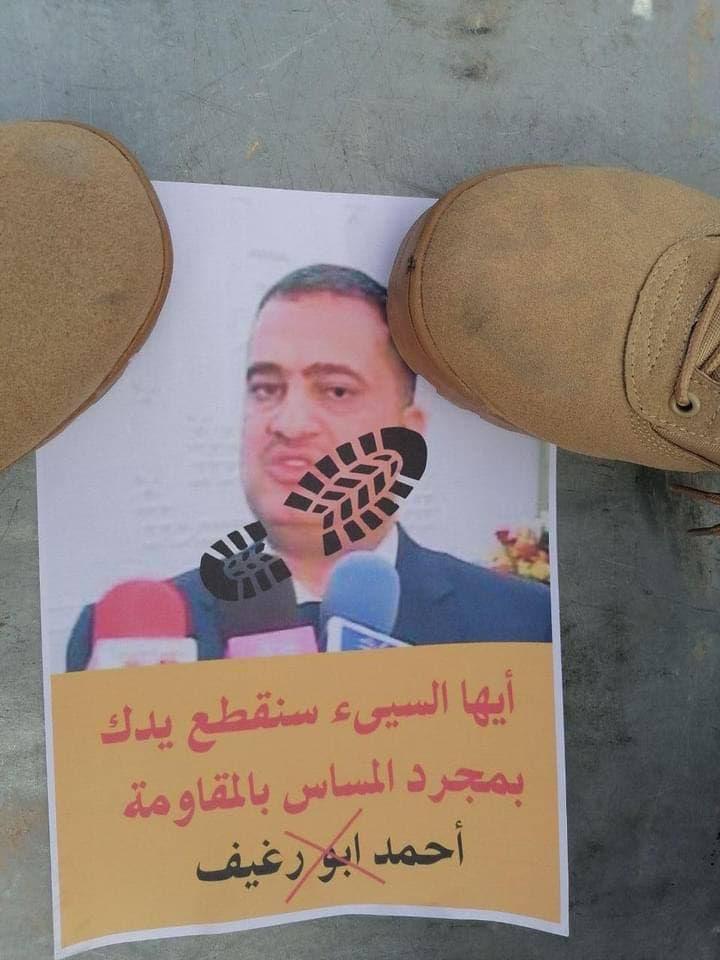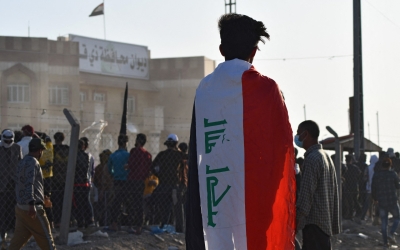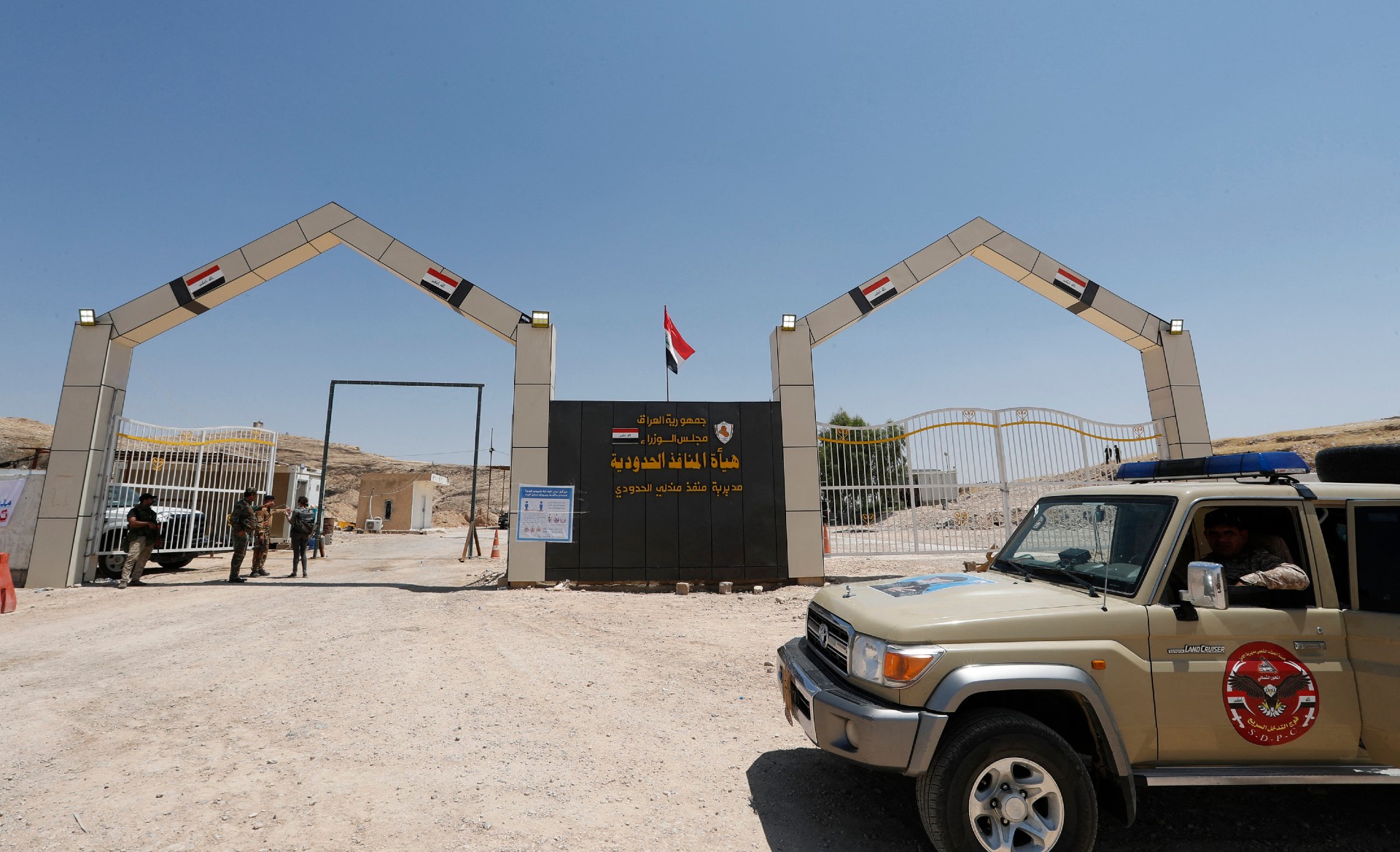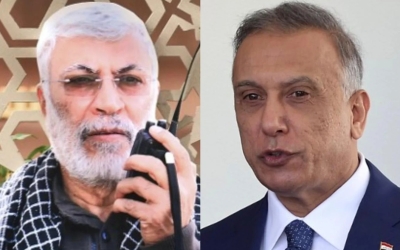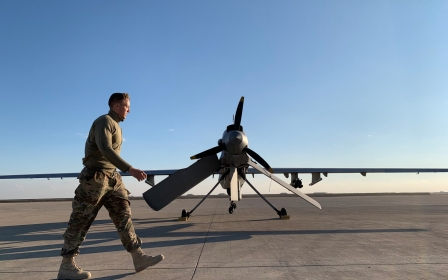Iraq: Paramilitaries feel the heat as Kadhimi steps up moves against them
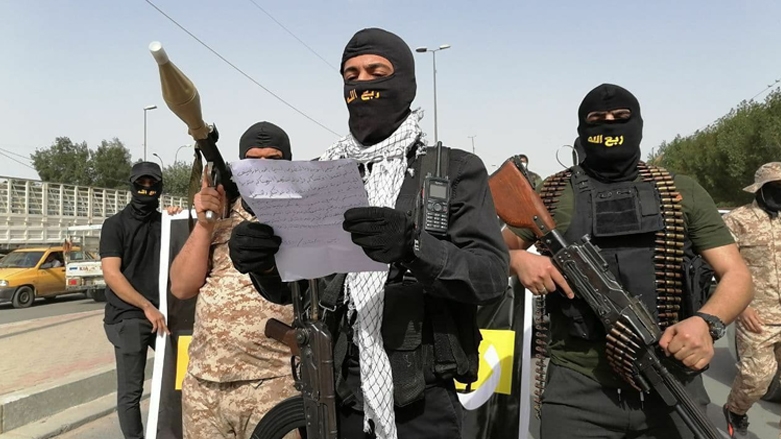
Baghdadis stepping out to run errands or get to work were surprised on 25 March. Rolling down the road in the capital’s centre and south were dozens of military-grade Toyota Land Cruisers, some with heavy guns attached, and scores of masked fighters parading in full uniform.
None of the vehicles bore signs revealing their affiliation, though some fighters carried little Iraqi flags and threatening pictures of Prime Minister Mustafa al-Kadhimi and his ally Major General Ahmed Abu Ragheef, deputy interior minister for intelligence affairs.
On Kadhimi and Abu Rageef’s faces were printed footprints, and beneath were written slogans like "We will cut off the offender's ear" and "It is time to cut off [Kadhimi's] ears".
All in all, the spectacle lasted no longer than half an hour. But footage of it was broadcast on Telegram channels and websites belonging to Iranian-backed armed factions.
New MEE newsletter: Jerusalem Dispatch
Sign up to get the latest insights and analysis on Israel-Palestine, alongside Turkey Unpacked and other MEE newsletters
In the clips, masked fighters were seen reading a statement demanding the approval of the annual budget and the reinstatement of the previous US dollar exchange rate.
They also identified themselves as "Rabaa Allah", a faction only heard of occasionally before. Many were unconvinced, however.
"There is no armed group named Rabaa Allah. Rabaa Allah is a different story. These are Kataeb Hezbollah fighters,” a senior commander of the Popular Mobilisation paramilitary forces, which includes the Iran-backed faction, told Middle East Eye.
"Some of these forces are officially registered with the Popular Mobilisation Authority [PMA], and most of these wheels and weapons they used in the parade are part of those owned by the PMA,” he added.
“The inclusion of PMA vehicles and forces in this parade was a matter of great disagreement between the leadership of the Popular Mobilisation forces and the leadership of the Kataeb Hezbollah."
Unusually, Kataeb Hezbollah responded to the outcry stirred up by the parade. Its leadership said the forces were simply being repositioned in a “routine” manoeuvre, and “some enthusiastic, uncontrolled youth have taken advantage of this to express deserving demands, but in a way that is not acceptable to us".
That attempt at distancing convinced no one. Instead, it only drew more attention to the faction, as well as several questions:
Why did Kataeb Hezbollah believe it prudent to reveal its hardware? What was the purpose of the show? And what message was the group trying to send Kadhimi?
The answer, sources in the Iranian-backed armed factions, security services and government agencies have revealed, is that Kataeb Hezbollah and other groups are beginning to feel the heat, as Kadhimi bit by bit targets their power.
'It started as a joke'
To understand the parade and its meaning, it is worth exploring how the opaque group known as Rabah Allah first hit the Iraqi scene.
In its Telegram channel, which was only established in September, Rabaa Allah describes itself as a civic group that “undertakes to silence the mouths that offend the Islamic faith and its sacred branches”.
The group’s activities were initially limited to pursuing parties and media institutions that "abuse" figures and armed factions backed by Iran.
Its most prominent appearance was in Baghdad in October, when it burnt down the headquarters of the Kurdistan Democratic Party in protest against one of its leaders’ criticisms of the Popular Mobilisation.
Despite the arrest of a number of its members who participated in the arson, the group began to regularly broadcast videos of its other activities.
A second, shocking incident in November saw some 20 youths wearing its trademark black T-shirts raiding a massage parlour, filming themselves smashing furniture, pulling women onto the street and beating them.
CCTV recordings from the buildings beside the Shelan Fitness and Massage Centre, which were later leaked, showed the group's members moving comfortably without tension or fear, even though it is located in the heart of Karrada, one of the most vibrant and sensitive neighbourhoods in Baghdad, which hosts the offices of dozens of political parties, government agencies and media outlets - not to mention many security forces.
"Rabaa Allah started as a joke. A group of young people from several armed factions agreed to teach the media channels targeting the PMFs and the [Iranian-backed armed] factions a lesson," a prominent Shia commander familiar with the group’s birth told MEE.
"At the beginning, the group mainly included members from Kataeb Hezbollah and Asaib Ahl al-Haq, and the matter was not coordinated with the leaderships. But the joke achieved the required purpose with the least effort, so it was employed by Kataeb Hezbollah,” he added.
"Attacking the Shelan Centre represented a crossroads for a large number of the group's members, so Asaib Ahl al-Haq’s members withdrew and the group became completely affiliated with Kataeb Hezbollah."
Hours after the massage parlour was attacked, several statements were issued denying Rabaa Allah’s connection to the raid. However, the Telegram channel linked to the group published a number of videos documenting the attack and a statement claiming responsibility for the operation that targeted "one of the immorality and debauchery centres".
After that it kept a low profile. Until the Baghdad parade, that is.
Kataeb Hezbollah's show of force
The spark that drew Rabaa Allah, or rather, Kataeb Hezbollah, out again was lit two days earlier.
Baghdad was relatively calm on the morning of 23 March. At least as calm as the Iraqi capital can be, with its suffocating traffic jams.
But this calm did not last long.
Suddenly and without warning, a motorbike with two passengers collided with a jeep near northern Baghdad’s al-Mashtal Bridge, flipping the bike and causing it to blow up.
The authorities cordoned off the site and evacuated the victims to the nearest hospital, later issuing a statement saying that the bike ignited because it contained an explosive device, killing the driver and wounding his companion.
Many people would not have paid attention to the bike explosion were it not for some suspicious movements in the following hours that raised questions about the identity of the bikers, their affiliations and what they were doing.
Initial information suggested that the bikers were fighters from Saraya al-Salam, the armed wing of the influential Shia cleric Muqtada al-Sadr, and that they were on their way to blow up a liquor store in the area.
Information MEE obtained about the wounded man from Sadr City confirmed that he and his companion were registered Saraya al-Salam fighters deployed in Samarra, north of Baghdad.
Hours later, an eight-wheeled Toyota truck loaded with Kataeb Hezbollah fighters stopped in front of the hospital where the wounded man was receiving treatment.
'Kadhimi seeks through these security changes to control the country, so he can renew his term in office for a second round'
- Muhammad al-Baldawi,
Sadiqon political bloc
The militants tried to storm the hospital to get him, but a force linked to Kadhimi’s office arrived at the scene, took the wounded man and left without rising to the fighters’ threats, eyewitnesses told MEE.
Following that furore, people began asking what relationship the Sadrist had to Kataeb Hezbollah, and why the faction would risk a public brouhaha by attacking a hospital just to get their hands on him.
"The arrested wounded man is one of our registered fighters, but unfortunately he works with them [Kataeb],” a senior Sadrist leader told MEE.
"Both of them [the bikers] worked with Kataeb Hezbollah. They tried to release the wounded man so that he would not reveal his association with them or any information about what they were doing."
Changing the guard
Another brush-up between the prime minister and armed factions publicly emerged days earlier, on 14 March.
Qais al-Khazali, commander of fearsome Shia armed faction Asaib Ahl al-Haq, took to Twitter to claim an Emirati security team had touched down in Iraq to "run the intelligence apparatus". He questioned if the UAE delegation was behind the decision to replace 300 officers from their posts at strategic border crossings.
"I do not know the reason for the silence or complacency regarding this issue. What has been going on for some time ... is dangerous and threatens the future of the state," he said.
'Kadhimi carried out a very huge readjustment operation this time. He killed two birds with one stone'
- prominent Shia political ally of Kadhimi
In the days that followed the Khazali tweet, members of his political wing, the Sadiqoun bloc, led a media campaign accusing Kadhimi of carrying out a "soft coup" to control the security services by replacing their leaders in provinces across Iraq.
"Kadhimi seeks through these security changes to control the country, so he can renew his term in office for a second round,” Sadiqoun’s Muhammad al-Baldawi told reporters.
"The prime minister, Mustafa al-Kadhimi, began implementing the soft coup project a long time ago through the replacement processes that affected the leaders of the security services in the various governorates of Iraq."
The next day, the head of the parliamentary security and defence committee, Lieutenant General Muhammad Ridha al-Haidar, denied the presence of a UAE security team and said "the accusations directed against the Iraqi intelligence service regarding the Emirates are untrue ... and baseless".
But Khazali’s claim that 300 intelligence agents had been replaced at border crossings was entirely correct.
An official governmental letter dated 24 November and seen by Middle East Eye shows that Kadhimi that month ordered “good staff” at various ministries and independent bodies to be transferred to the Border Ports Authority, including 300 from the intelligence service.
Although the order was issued in November, the internal committee formed within the intelligence service to decide who was to be transferred to the Border Ports Authority did not complete its work until March, security officials told the MEE.
What angered the leaders of the Iranian-backed forces, especially Asaib Ahl al-Haq and Kataeb Hezbollah, was that dozens of those replaced were officers "close" to the armed factions and political forces loyal to Tehran, officials said.
These were the men acting as the “eyes and arms” of those factions within the intelligence apparatus, they added.
The officers who replaced them included dozens of senior and well-trained men specialised in important areas such as counter-espionage, information gathering, internal espionage, international cooperation and strategic analysis.
"Kadhimi carried out a very huge readjustment operation this time. He killed two birds with one stone,” a prominent Shia political ally of Kadhimi told MEE.
“He got rid of their [militia] men inside the apparatus, and deployed his own men at the border crossings.
"He keeps quietly clipping their wings inside the security services. That is why they are very provocative, and they feel that he has become a real threat against them, and that he is really starting to stifle them."
Losing grip
In recent years, the Iranian-backed political and armed factions and their allies have occupied high-ranking offices in various sensitive security services, giving them wide-ranging power.
The National Intelligence Service, the National Security Agency, the national security adviser, the Internal Intelligence Agency, the elite Falcons Cell, and the Supreme Technical Committee for Information and Communication Security are among the most important official security agencies that the Tehran-allied armed factions and political forces controlled until last year.
But Kadhimi has managed to prize them all from the factions’ hands under one pretext or another, security officials told MEE.
The Interior Intelligence Agency and the Falcons Cell, the most prominent domestic intelligence units in terms of technical and human capabilities, which had not previously used their resources to pursue the Iranian-backed factions, have been in the prime minister’s hands since January.
'They now see Kadhimi’s actions are an organised strategic action and not related to current goals, and that if they do not confront it now, they will find themselves in his hands later'
- Prominent commander of an armed group
Kadhimi attached the Falcons Cell directly to his military office, while the intelligence agency was handed over to Abu Ragheef, one of his most prominent aides known for his boldness and experience in the intelligence field, as well as his lack of fear of the armed factions.
Since then, information about the factions’ illegal activities, their men, their collaborators and their financiers began flowing in, security officials and politicians close to Kadhimi told MEE.
Several small armed groups involved in the assassination of activists, journalists and former officials were revealed, leading to a number of arrests in Basra in February. Meanwhile, a number of other small groups involved in attacking the military convoys, Baghdad airport and military bases in the capital and Diwaniyah were arrested.
All these arrests targeting a number of businessmen, investors and officials involved in financing armed factions took place and are taking place under the supervision of Abu Ragheef. More are planned to come.
"The changes that Kadhimi has made in the leadership of the security services, and the work of the Interior Intelligence Agency and the Falcons Cell, have become a source of concern for the factions,” a prominent commander of an armed group told MEE.
“Abu Ali al-Basri [the former head of the Falcons Cell] limited his work to the Islamic State and the Sunni armed groups, and turned a blind eye to everything related to the factions.
"What is happening now is that the agency and the Cell were directed to collect information about the movement of these factions’ militants, their connections, their funding and everything related to them.”
The commander said for now these activities do not pose the factions a direct threat, but Kadhimi is getting closer and beginning to target their funding.
“He may arrest them [commanders of armed factions] in the future or use this information to threaten their personal security. They now see Kadhimi’s actions are an organised strategic action and not related to current goals, and that if they do not confront it now, they will find themselves in his hands later.”
Isolating Kataeb Hezbollah
Though the Iran-backed armed factions ostensibly operate under the governmental umbrella of the Popular Mobilization Authority, in essence they use the PMA and its regalia as cover for their illegal activities.
In December, four armed groups loyal to Iraq’s Grand Ayatollah Ali al-Sistani rather than Iranian Supreme Leader Ali Khamenei split from the PMA in protest at the Iran-backed factions’ dominance.
Since then, Falih al-Fayyad, head of the PMA, and Abu Fadak al-Mohammadawi, its chief of staff, as well as other leaders close to Iran, have sought to relieve local and international pressure on the paramilitary force and improve its image.
Another vast challenge they are attempting to overcome is containing the chaos left by the January 2020 US assassination of Abu Mahdi al-Muhandis, the former deputy head of the PMA and godfather of most Iraqi armed factions, and top Iranian General Qassem Soleimani.
However, these efforts continue to collide with the stubbornness and intransigence of the factions’ commanders, who want to dominate Iraq and believe Fayyad, Abu Fadek and the Iranian intelligence ministry are trying to tame the Popular Mobilisation and hand it to Kadhimi, who they consider Washington’s man.
Kataeb Hezbollah is at the forefront, commanders of armed factions, security officials and politicians told MEE.
The faction now feels “isolated" as Fayyad and Abu Fadek get closer to Kadhimi.
The pair’s plan to participate in the upcoming October elections by backing an independent list including candidates close to the Popular Mobilisation has also unnerved some armed factions.
Asaib Ahl al-Haq’s Khazali wants to position himself as the heir of Hadi al-Amiri, head of Badr Organisation, the oldest Shia armed faction, and lead the Iranian-backed al-Fatah parliamentary bloc.
But Abu Hussein, Kataeb Hezbollah’s current military commander, sees himself as the man to take that mantle, and "insists on dragging others into his trench" to get their cover, armed factions commanders told MEE.
“Asaib Ahl al-Haq has a political project, and although Khazali launches major media attacks on Kadhimi from time to time, he and his men are not publicly involved in any illegal actions, unlike Kataeb Hezballah,” a senior PMA commander said.
“Abu Fadak is clearly getting close to Kadhimi and is seeking to draw the PMA into the state’s orbit, and for Abu Hussein this means he will be outside the circle and will be easier to be hit,” he added.
'Kataeb Hezbollah now is in its weakest state compared to the rest of the factions, and therefore it is floundering under the weight of their feelings of anger'
- Senior commander of Iran-backed faction
"The military parade, using the PMA’s vehicles and its forces, was aimed at dragging everyone into Abu Hussein’s camp and informing everyone that these forces will never be under the control of the government.”
What Abu Hussein did not expect, according to several faction commanders and officials, was the reactions that he received from Fayyad and Abu Faddak, who both issued a statement saying that they had nothing to do with the parade and that the concerned security services should go after those who violate the law.
Similarly, Amiri and Khazali said that they would abandon Kataeb Hezbollah if such behaviour was repeated again in the future.
“Everyone saw that parade as a childish act that negatively impacts all Shia factions and projects. So, Abu Hussein was forced to issue a statement declaring that his forces were not demonstrating militarily and condemning the behavior of his fighters. This is an unprecedented act by a Kataeb Hezbollah leader,” said a senior commander of an Iranian-backed armed faction, who is familiar with the meetings held at Amiri’s house and Fayadd’s office after the parade.
"Kataeb Hezbollah now is in its weakest state compared to the rest of the factions, and therefore it is floundering under the weight of their feelings of anger,” he added.
“The next period will either witness it calming and returning to the fold, or staying out alone, which means it will be easy to be hit.”
Middle East Eye delivers independent and unrivalled coverage and analysis of the Middle East, North Africa and beyond. To learn more about republishing this content and the associated fees, please fill out this form. More about MEE can be found here.


